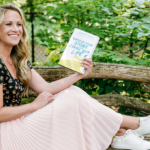I’d love to give you a secret formula for how to write a book. The bad news is that there isn’t one. The good news is that this means you get to find one that works for you.
Having written two books now, I can tell you it is as hard as people say it is. I can also tell you I had to find my own way through my writing process.
For example, some people are great at setting aside small amounts of time to write every day. I tried that approach and ended up in a total mess. Now, I give myself weeks in a row when my only job is to write. It can be lonely, but it works for me.
In this week’s SUCCESS Stories, I explain my personal approach to writing books. It’s based on my experience writing my first book, Stories That Stick, which is available now, and the upcoming Choose Your Story, Change Your Life.
I’ll cover my lengthy outlining process and why it’s worth your time, what gathering ideas looks like for me, and how to build a writing cave in your schedule and your space.
Outlining may take longer than writing.
My outlines start with parts, which are divided into chapters, which are divided into subheads, which are divided into more subheads, which are divided into points.
I always thought that my thorough approach to outlining—to the point that it takes longer than the writing—was an act of procrastination. In fact, I’ve realized that building the strong frame of a clear and detailed outline makes the actual writing so much easier.
Writing a book is like running a marathon. Those first few steps are fresh and exciting, but the further you go, the more tired you get. Suddenly, you’re not sure if you can keep putting one foot in front of the other. Except instead of steps and miles, it’s words and chapters.
Having an outline helps you stay on track. It acts as a series of friendly signposts guiding you towards the finish line, so you aren’t left desperately floundering, losing track of your progress and your point.
To create my outline, I use a system knowable only unto myself that involves scraps of paper, many different colored pens, and files that sometimes get lost. I personally like the feeling of physically putting pen to paper, and of moving paper around until the structure makes sense to me.
Organize your outline in a way that makes sense to you—and thank yourself later.
Constantly gather data points.
As my ideas and the structure of my outline are percolating in my head, I’m constantly collecting stories and research that will bind my book together. I call this process gathering.
Places where I look for these data points include:
- Conversations I’ve had and overheard
- Podcasts I’ve listened to
- Articles I’ve read
I also make use of content I’ve already created, such as:
- Blog posts
- Articles
- Instagram captions
- Videos
- Podcast episodes
Inspiration is everywhere: the hardest part is recording it right then so you can use it later. My imperfect but functional system for noting the things I’ve gathered involves:
- Emailing the idea to myself: I include enough context so I’ll understand it months later. I add labels and tags, e.g. Book 3, so when I’ve finished my outline, and it’s time to write, I have everything relevant in one place in my inbox.
- Writing it down on note cards: This is especially useful when I’m on the go. I personally prefer it to using a notes app. I put all my note cards in a bag and when I’m ready to write, I pour them all out and fit them in the appropriate places in my outline.
Even when you aren’t actively working on a book, keep gathering: those stories might be exactly what you need in the future.
Carve yourself a writing cave.
Some writers can be productive writing for an hour here and an hour there, but that doesn’t work for me. I have to create a writing cave: time and space devoted entirely to writing.
On the time front, once I have my outline ready, I only need about six weeks for the actual writing. I push to meet my other professional commitments early, and even turn some down, so I can use that entire time just to write.
Carving out space has been trickier, especially during the pandemic, when our house became my office, my husband’s office, and classrooms for our third- and fourth-graders, which is why I have to shout out to our wonderful nanny for her help with virtual school.
My noise-canceling headphones and Spotify playlist help drown out distractions. I like writing to energetic songs. They distract my ego, which allows me to tap into my creative self.
Everyone knows that my closed door means Do Not Disturb. But I try to finish at 4 p.m., and set aside lunch on Mondays to see friends.
Set writing goals.
Now you’re ready to write. I start by getting together all the scraps of paper with my outline and gathering clips on, and cutting and sticking them together onto a long sheet of paper.
This shows me which chapters are fully fleshed out, and which need more information. I start with the ones that have the most detail. This gives me time to gather more on the other chapters.
As extra motivation, I set myself writing goals, based on how many words I want to write by a certain deadline. This gives me a sense of progress and holds me accountable—especially when I post it on social media. Even if no one pays attention, knowing it’s out in public pushes me to live up to my self-imposed standards.
Different writers have different processes, but I find that reading about the writing habits of successful authors helps me—and I hope this helps you.
SUCCESS Stories is no longer releasing new episodes on the SUCCESS Podcast Network, but you can still listen to the full conversation below.












